Why Do Homeless Families Exit and Return the Homeless Shelter? Factors Affecting the Risk of Family Homelessness in Salt Lake County (Utah, United States) as a Case Study
Abstract
1. Introduction
2. Literature Review
2.1. Understanding the Dynamics of Family Homelessness
2.2. Identifying Factors Affecting the Risk of Family Homelessness
3. Data and Methods
3.1. Data
3.1.1. Data Sample
3.1.2. Data Processing for Homeless Family Selection
3.2. Case Study Selection: Salt Lake County, Utah
3.3. Methods
4. Results
4.1. Descriptive Statistics of the HMIS Data Sample
4.2. Multivariate Analyses
4.2.1. Factors Affecting Shelter Exit
4.2.2. Factors Affecting Shelter Reentry
5. Discussion
5.1. Estimates of Time for Staying and Exiting the Shelter
5.2. Effects of Individual Factors on Shelter Exit and Return
5.3. Effects of Structural Factors on Shelter Exit and Return
6. Conclusions
Author Contributions
Funding
Acknowledgments
Conflicts of Interest
References
- U.S. Department of Housing and Urban Development. Family Options Study: Short-Term Impacts of Housing and Services Interventions for Homeless Families, 2016. Available online: https://www.huduser.gov/portal/sites/default/files/pdf/FamilyOptionsStudy_final.pdf (accessed on 5 November 2019).
- Hopper, K. Homelessness old and new: The matter of definition. Hous. Policy Debate 1991, 2, 755–813. [Google Scholar] [CrossRef]
- Hopper, K. Definitional quandaries and other hazards in counting the homeless: An invited commentary. Am. J. Orthopsychiatry 1995, 65, 340–346. [Google Scholar] [CrossRef] [PubMed]
- Gould, T.E.; Williams, A.R. Family Homelessness: An Investigation of Structural Effects. J. Hum. Behav. Soc. Environ. 2010, 20, 170–192. [Google Scholar] [CrossRef]
- Piliavin, I.; Entner Wright, B.R.; Mare, R.D.; Westerfelt, A.H. Exits from and Returns to Homelessness. Soc. Serv. Rev. 1996, 70, 33–57. [Google Scholar] [CrossRef]
- McChesney, K.Y. Family Homelessness: A Systemic Problem. J. Soc. Issues 1990, 46, 191–205. [Google Scholar] [CrossRef]
- Bassuk, E.L.; Rosenberg, L. Why does family homelessness occur? A case-control study. Am. J. Public Health 1988, 78, 783–788. [Google Scholar] [CrossRef]
- Nunex, R.; Fox, C. A Snapshot of Family Homelessness Across America. Polit. Sci. Q. 1999, 114, 289–307. [Google Scholar] [CrossRef]
- Metraux, S.; Culhane, D.P. Family Dynamics, Housing, and Recurring Homelessness among Women in New York City Homeless Shelters. J. Fam. Issues 1999, 20, 371–396. [Google Scholar] [CrossRef]
- Cunningham, M. Preventing and Ending Homelessness: Next Steps for Policymakers; The Urban Institute: Washington, DC, USA, 2009. [Google Scholar]
- Shinn, M.; Weitzman, B.C.; Stojanovic, D.; Knickman, J.R.; Jiménez, L.; Duchon, L.; James, S.; Krantz, D.H. Predictors of homelessness among families in New York City: From shelter request to housing stability. Am. J. Public Health 1998, 88, 1651–1657. [Google Scholar] [CrossRef]
- Rog, D.; Buckner, J.C. Homeless families and children. In Toward Understanding Homelessness, Proceedings of the 2007 National Symposium on Homelessness Research, Washington, DC, USA, 1–2 March 2007; Dennis, D., Locke, G., Khadduri, J., Eds.; U.S. Department of Housing and Urban Development and Department of Health and Human Services: Washington, DC, USA, 2007. [Google Scholar]
- Shinn, M.B.; Rog, D.; Culhane, D. Family Homelessness: Background Research Findings and Policy Options. Dep. Pap. 2005, 83, 28. [Google Scholar]
- Culhane, D.; Metraux, S. One-year rates of public shelter utilization by race/ethnicity, age, sex and poverty status for New York City (1990 and 1995) and Philadelphia (1995). Popul. Res. Policy Rev. 1999, 18, 219–236. [Google Scholar] [CrossRef]
- Weitzman, B.C.; Knickman, J.R.; Shinn, M. Pathways to Homelessness among New York City Families. J. Soc. Issues 1990, 46, 125–140. [Google Scholar] [CrossRef]
- Culhane, D.P.; Metraux, S.; Park, J.M.; Schretzman, M.; Valente, J. Testing a typology of family homelessness based on patterns of public shelter utilization in four U.S. jurisdictions: Implications for policy and program planning. Hous. Policy Debate 2007, 18, 1–28. [Google Scholar] [CrossRef]
- Kuhn, R.; Culhane, D.P. Applying Cluster Analysis to Test a Typology of Homelessness by Pattern of Shelter Utilization: Results from the Analysis of Administrative Data. Am. J. Community Psychol. 1998, 26, 207–232. [Google Scholar] [CrossRef]
- Tischler, V.; Rademeyer, A.; Vostanis, P. Mothers experiencing homelessness: Mental health, support and social care needs. Health Soc. Care Community 2006, 15, 246–253. [Google Scholar] [CrossRef]
- Zima, B.T.; Wells, K.B.; Benjamin, B.; Duan, N. Mental Health Problems Among Homeless Mothers. Arch. Gen. Psychiatry 1996, 53, 332. [Google Scholar] [CrossRef]
- Masten, A.S.; Miliotis, D. Children in homeless families: Risks to mental health and development. J. Consult. Clin. Psychol. 1993, 61, 335–343. [Google Scholar] [CrossRef]
- Rafferty, Y.; Shinn, M. The impact of homelessness on children. Am. Psychol. 1991, 46, 1170–1179. [Google Scholar] [CrossRef]
- Buckner, J.C.; Bassuk, E.L.; Zima, B.T. Mental health issues affecting homeless women: Implications for intervention. Am. J. Orthopsychiatry 1993, 63, 385–399. [Google Scholar] [CrossRef]
- Koegel, P.; Sullivan, G.; Burnam, A.; Morton, S.C.; Wenzel, S. Utilization of mental health and substance abuse services among homeless adults in Los Angeles. Med. Care 1999, 37, 306–317. [Google Scholar] [CrossRef]
- Gewirtz, A.; Hart-Shegos, E.; Medhanie, A. Psychosocial Status of Homeless Children and Youth in Family Supportive Housing. Am. Behav. Sci. 2008, 51, 810–823. [Google Scholar] [CrossRef]
- McChesney, K.Y. A Review of the Empirical Literature on Contemporary Urban Homeless Families. Soc. Serv. Rev. 1995, 69, 429–460. [Google Scholar] [CrossRef]
- Burt, M.R.; Aron, L.Y.; Douglas, T.J.E.B. Homelessness: Programs and the People They Serve; Summary Report. Findings of the National Survey of Homeless Assistance Providers and Clients; Urban Institute: Washington, DC, USA, 1999. [Google Scholar]
- Meanwell, E. Experiencing Homelessness: A Review of Recent Literature. Sociol. Compass 2012, 6, 72–85. [Google Scholar] [CrossRef]
- Grant, R.; Gracy, D.; Goldsmith, G. Twenty-five years of child and family homelessness: Where are we now? Am. J. Public Health 2013, 103 (Suppl. 2), e1–e10. [Google Scholar] [CrossRef]
- Bassuk, E.L.; DeCandia, C.J.; Tsertsvadze, A.; Richard, M.K. The effectiveness of housing interventions and housing and service interventions on ending family homelessness: A systematic review. Am. J. Orthopsychiatry 2014, 84, 457–474. [Google Scholar] [CrossRef]
- Bassuk, E.L.; Weinreb, L.F.; Buckner, J.C.; Browne, A.; Salomon, A.; Bassuk, S.S. The Characteristics and Needs of Sheltered Homeless and Low-Income Housed Mothers. J. Am. Med. Assoc. 1996, 276, 640. [Google Scholar] [CrossRef]
- Lehmann, E.R.; Kass, P.H.; Drake, C.M.; Nichols, S.B. Risk factors for first-time homelessness in low-income women. Am. J. Orthopsychiatry 2007, 77, 20–28. [Google Scholar] [CrossRef]
- Bassuk, E.L.; Geller, S. The role of housing and services in ending family homelessness. Hous. Policy Debate 2006, 17, 781–806. [Google Scholar] [CrossRef]
- Stojanovic, D.; Weitzman, B.C.; Shinn, M.; Labay, L.E.; Williams, N.P. Tracing the path out of homelessness: The housing patterns of families after exiting shelter. J. Community Psychol. 1999, 27, 199–208. [Google Scholar] [CrossRef]
- Burt, M.R.; Pearson, C.; Montgomery, A.E. Community-Wide Strategies for Preventing Homelessness: Recent Evidence. J. Prim. Prev. 2007, 28, 213–228. [Google Scholar] [CrossRef]
- Wong, Y.-L.I.; Piliavin, I. A Dynamic Analysis of Homeless-Domicile Transitions. Soc. Probl. 1997, 44, 408–423. [Google Scholar] [CrossRef]
- Ansderson, C.L. Opening doors: Prenvnting youth homelessness through housing and education collaboration. Seattle J. Soc. Just 2012, 11, 457–522. [Google Scholar]
- Fisher, B.W.; Mayberry, L.S.; Shinn, M.; Khadduri, J. Leaving Homelessness Behind: Housing Decisions Among Families Exiting Shelter. Hous. Policy Debate 2014, 24, 364–386. [Google Scholar] [CrossRef]
- Hanratty, M. Family Homelessness in Hennepin County: A Mixed Methods Examination of the Rapid Exit Program and Patterns of Shelter Mobility; Humphrey School of Public Affairs, University of Minnesota: Minneapolis, MN, USA, 4 May 2011. [Google Scholar]
- Rodriguez, J.M.; Eidelman, T.A. Homelessness Interventions in Georgia: Rapid Re-Housing, Transitional Housing, and the Likelihood of Returning to Shelter. Hous. Policy Debate 2017, 27, 825–842. [Google Scholar] [CrossRef]
- Vaclavik, D.; Brown, M.; Adenuga, P.; Scartozzi, S.; Watson, D.P. Permanent Housing Placement and Reentry to Services Among Family Recipients of Homelessness Prevention and Rapid Re-Housing Program (HPRP) Assistance. J. Prim. Prev. 2018, 39, 591–609. [Google Scholar] [CrossRef]
- Link, B.; Phelan, J.; Bresnahan, M.; Stueve, A.; Moore, R.; Susser, E. Lifetime and five-year prevalence of homelessness in the United States: New evidence on an old debate. Am. J. Orthopsychiatry 1995, 65, 347–354. [Google Scholar] [CrossRef]
- Dolbeare, C.N. Homelessness and the Low Income Housing Crisis. J. Sociol. Soc. Welf. 1992, 19, 151–176. [Google Scholar]
- Elliott, M.; Krivo, L.J. Structural Determinants of Homelessness in the United States. Soc. Probl. 1991, 38, 113–131. [Google Scholar] [CrossRef]
- Smith, N.; Flores, Z.D.; Lin, J.; Markovic, J. Understanding Family Homelessness in New York City: An In-Depth Study of Families’ Experiences Before and After Shelter; Vera Institute of Justice: New York, NY, USA, 2005. [Google Scholar]
- Lee, C.M.; Culhane, D.P. The Spatial Distribution of Homelessness Occurrence and the Efficacy of Shelter Programs in Philadelphia; Wharton Real Estate Center Working Paper Series, No. 213; University of Pennsylvania: Pennsylvania, PA, USA, 1995. [Google Scholar]
- García, I.; Rúa, M.M. ‘Our interests matter’: Puerto Rican older adults in the age of gentrification. Urban Stud. 2018, 55, 3168–3184. [Google Scholar] [CrossRef]
- Desmond, M. Evicted: Poverty and Profit in the American City; Broadway Books: New York, NY, USA, 2016. [Google Scholar]
- Desmond, M. Eviction and the reproduction of urban poverty. Am. J. Sociol. 2012, 118, 88–133. [Google Scholar] [CrossRef]
- Desmond, M. Unaffordable America: Poverty, Housing, and Eviction. Fast Focus Inst. Res. Poverty 2015, 22, 1–6. [Google Scholar]
- Desmond, M.; Gershenson, C.; Kiviat, B. Forced relocation and residential instability among urban renters. Soc. Serv. Rev. 2015, 89, 227–262. [Google Scholar] [CrossRef]
- May, J. Housing histories and homeless careers: A biographical approach. Hous. Stud. 2000, 15, 613–638. [Google Scholar] [CrossRef]
- Tejani, N.; Rosenheck, R.; Tsai, J.; Kasprow, W.; McGuire, J.F. Incarceration histories of homeless veterans and progression through a national supported housing program. Community Ment. Health J. 2014, 50, 514–519. [Google Scholar] [CrossRef]
- U.S. Department of Housing and Urban Development. HMIS Standards Data Dictionary (Version 1.3). Available online: https://files.hudexchange.info/resources/documents/HMIS-Data-Dictionary-2018.pdf (accessed on 15 May 2018).
- Metraux, S.; Culhane, D.P. Analyzing Shelter Stays and Shelter Stay Patterns Using Administrative Data: An Overview of Practical Methods. In Proceedings of the Homeless Service Data Users Meeting, Washington, DC, USA, 13–14 September 1999. [Google Scholar]
- Singer, J.D.; Willett, J.B. Applied Longitudinal Data Analysis: Modeling Change and Event Occurrence; Oxford University Press: New York, NY, USA, 2003; ISBN 0195152964. [Google Scholar]
- McCarty, D.; Argeriou, M.; Huebner, R.B.; Lubran, B. Alcoholism, drug abuse, and the homeless. Am. Psychol. 1991, 46, 1139–1148. [Google Scholar] [CrossRef]
- Robertson, M.J. Homeless women with children: The role of alcohol and other drug abuse. Am. Psychol. 1991, 46, 1198–1204. [Google Scholar] [CrossRef]
- Breakey, W.R.; Fischer, P.J.; Kramer, M.; Nestadt, G.; Romanoski, A.J.; Ross, A.; Royall, R.M.; Stine, O.C. Health and Mental Health Problems of Homeless Men and Women in Baltimore. J. Am. Med. Assoc. 1989, 262, 1352. [Google Scholar] [CrossRef]
- Johnson, T.P.; Freels, S.A.; Parsons, J.A.; Vangeest, J.B. Substance abuse and homelessness: Social selection or social adaptation? Addiction 1997, 92, 437–445. [Google Scholar] [CrossRef]
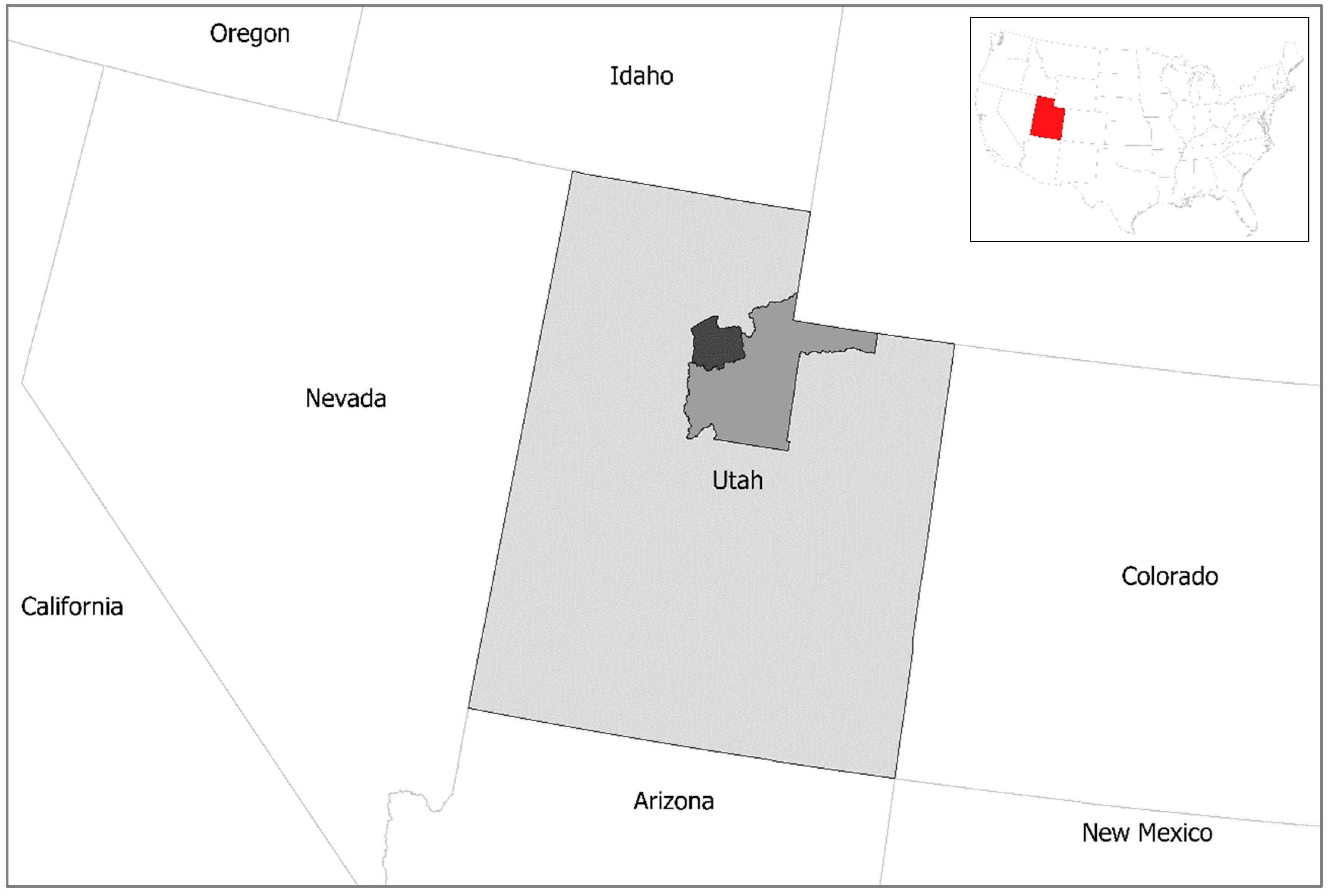
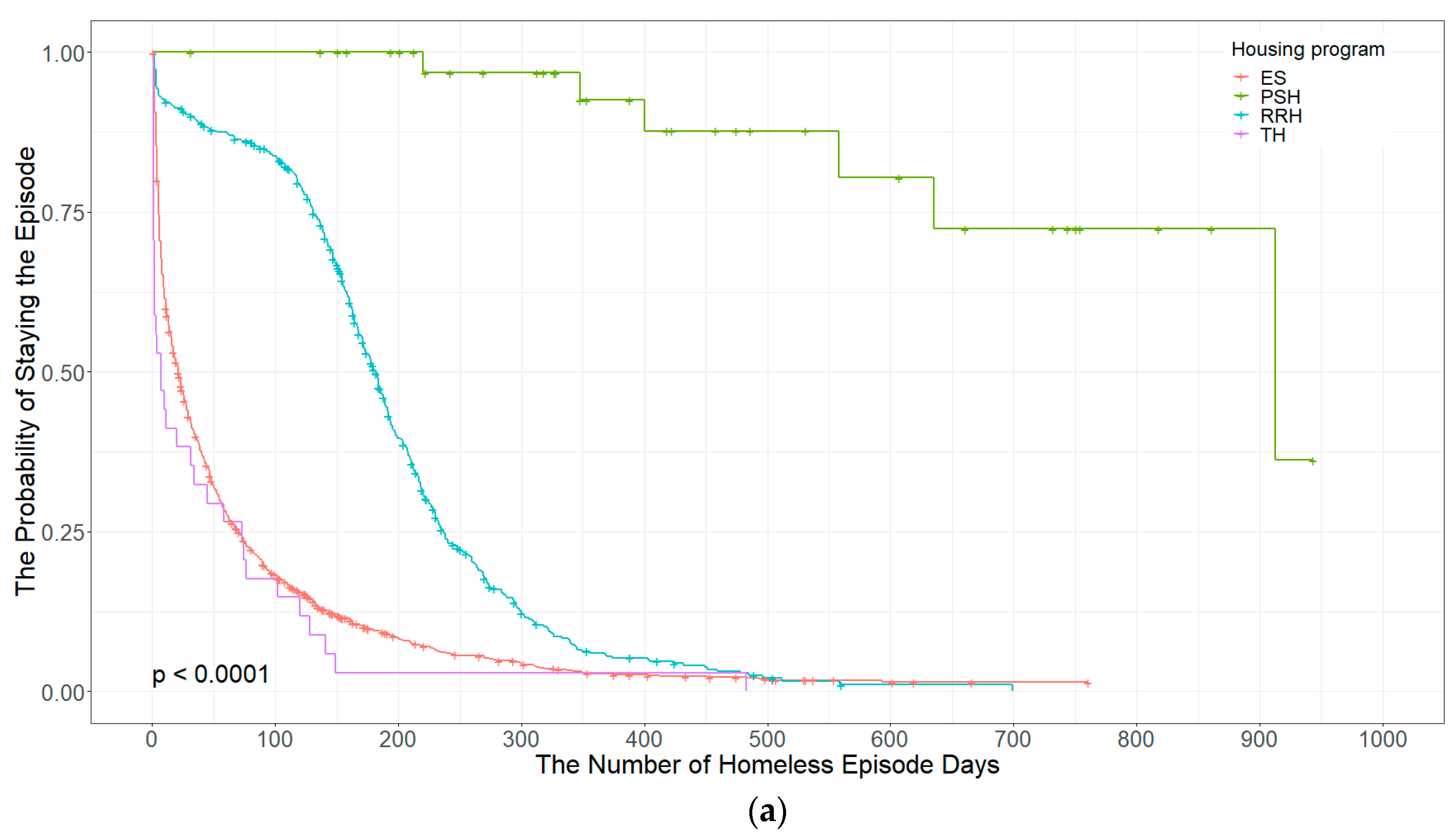
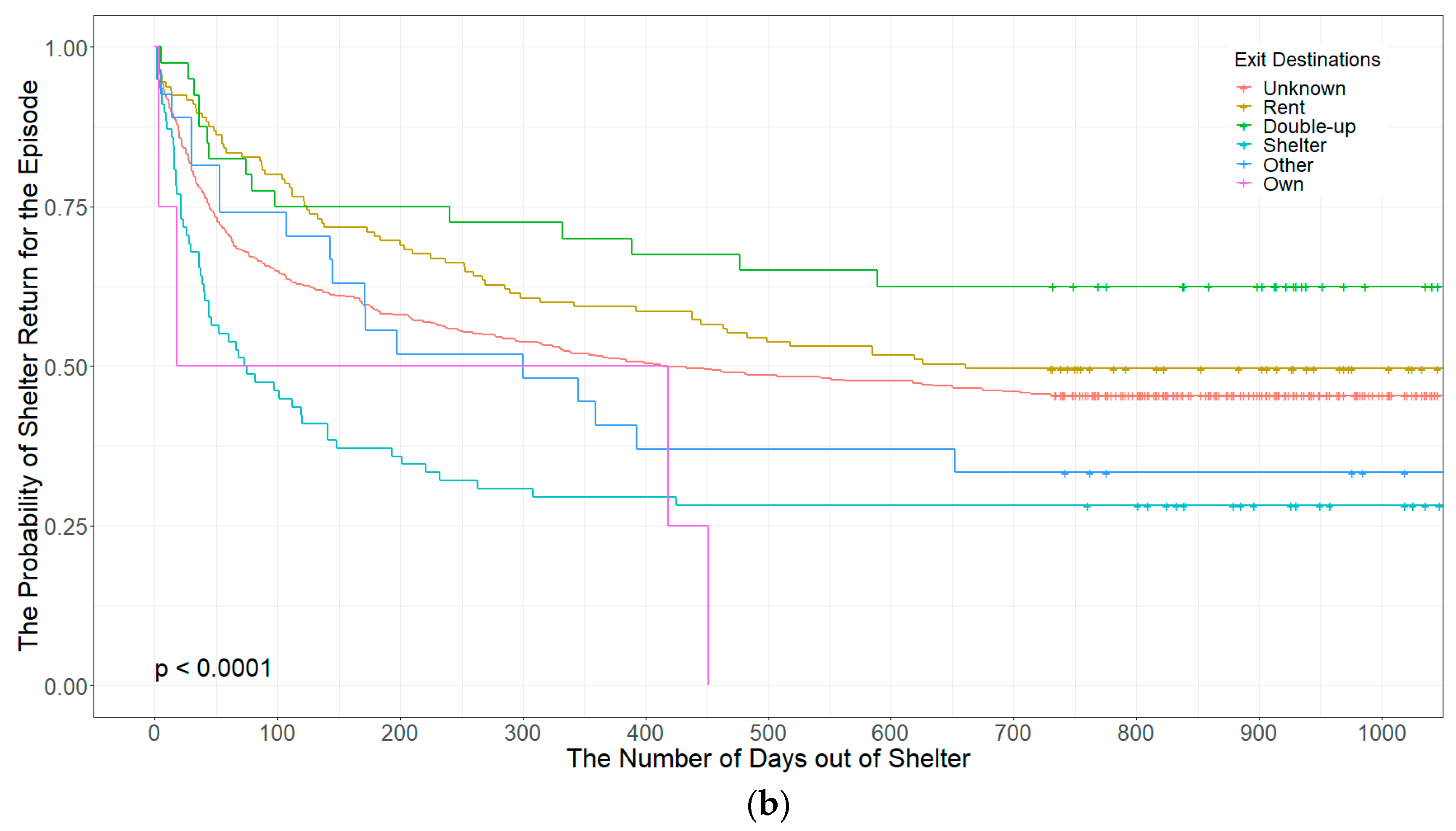
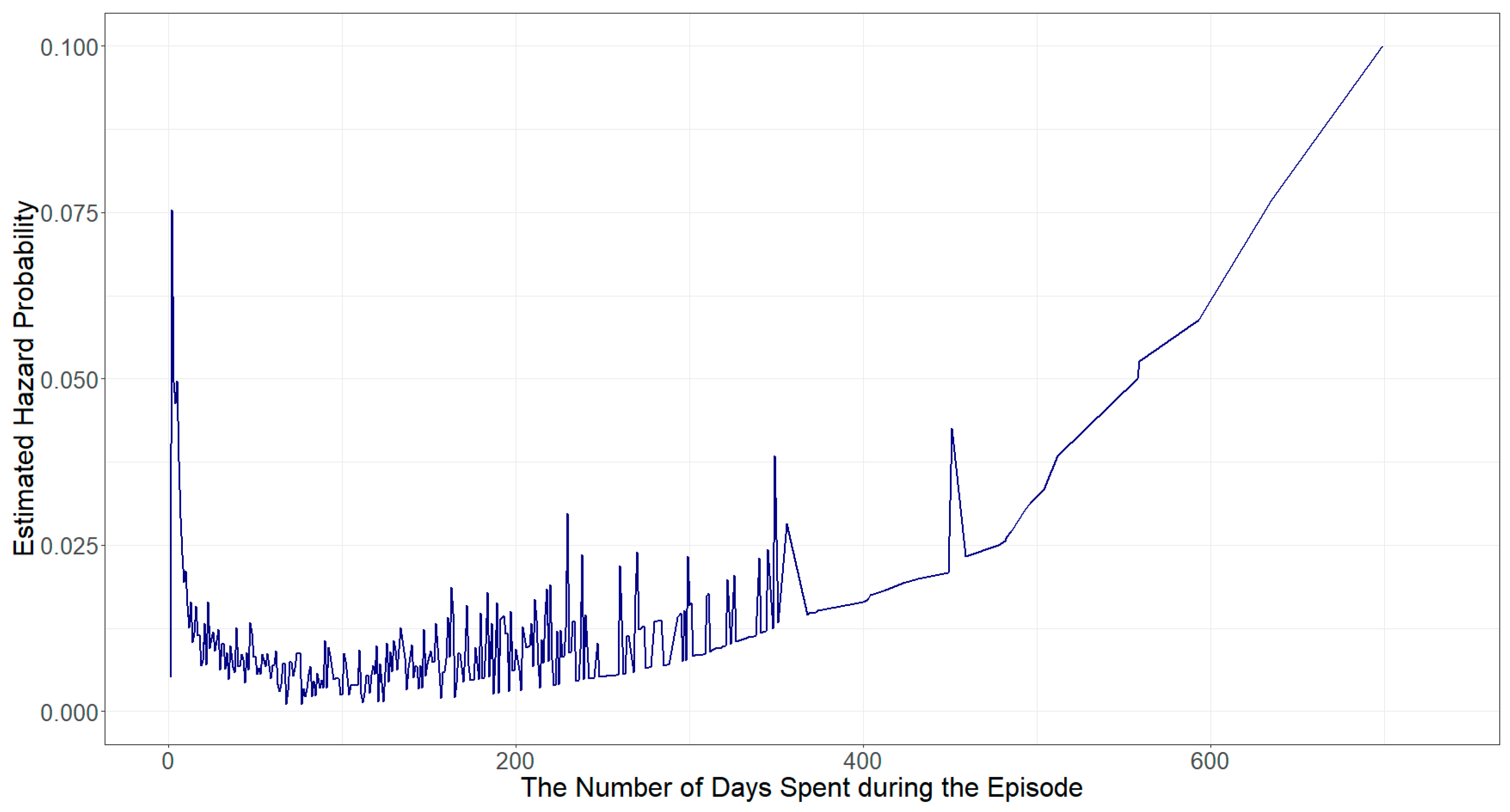

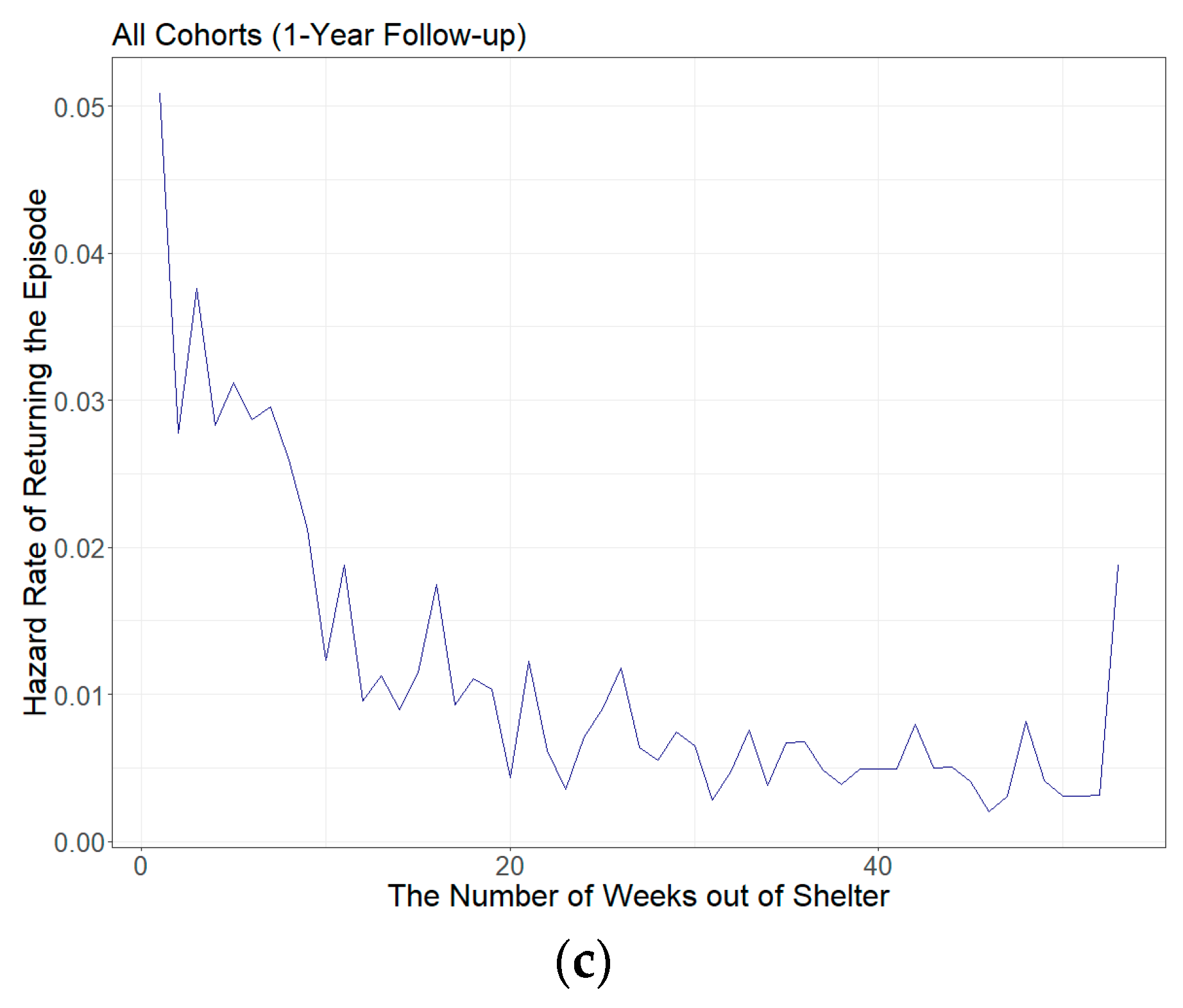
| CoC Name | Total | Homeless Characteristics | ||
|---|---|---|---|---|
| Sheltered | Unsheltered | Homeless Households | ||
| Salt Lake City & County CoC | 1804 | 1688 | 136 | 177 |
| Utah Balance of State CoC | 899 | 660 | 239 | 91 |
| Provo/Mountainland CoC | 173 | 128 | 45 | 19 |
| Total | 2876 | 2476 | 400 | 227 |
| Individual and Structural Variables | Episode Repeaters | Episode Non-Repeaters |
|---|---|---|
| n (1462) | 512 | 950 |
| Characteristics of a homeless family head | ||
| Gender (%) | ||
| Female | 31.1 | 55.4 |
| Male | 3.9 | 9.6 |
| Race (%) | ||
| White | 24.8 | 48.3 |
| Black | 5.0 | 7.5 |
| Indian/Native American | 3.6 | 5.0 |
| Asian/Pacific Islander | 1.6 | 4.2 |
| Hispanic (%) | 10.3 | 17.0 |
| Age when entering the shelter (%) | ||
| Under 20 | 0.5 | 0.8 |
| 20–29 | 12.5 | 22.2 |
| 30–39 | 15.7 | 28.2 |
| 40–49 | 4.8 | 11.0 |
| 50–59 | 1.4 | 2.7 |
| Over 60 | 0.1 | 0.1 |
| Disabling condition (%) | 18.3 | 29.8 |
| Veteran (%) | 0.8 | 1.7 |
| Health status (%) | ||
| Alcohol abuse | 0.9 | 1.7 |
| Chronic health | 8.8 | 15.2 |
| Drug abuse | 1.7 | 4.5 |
| Mental health | 9.6 | 17.4 |
| Homeless family characteristics | ||
| Family size (%) | ||
| 1 | 0.9 | 1.3 |
| 2 | 7.7 | 14.6 |
| 3 | 11.6 | 22.6 |
| 4 | 7.5 | 13.1 |
| 5 | 4.5 | 6.7 |
| More than 6 | 2.9 | 6.6 |
| The number of adults (%) | ||
| 1 | 17.2 | 32.8 |
| 2 | 17.0 | 29.8 |
| 3 | 0.8 | 2.0 |
| More than 4 | 0.1 | 0.3 |
| Children under five years old (%) | ||
| 0 | 13.0 | 25.5 |
| 1 | 14.8 | 26.3 |
| 2 | 4.9 | 10.3 |
| 3 | 1.8 | 2.4 |
| More than 4 | 0.5 | 0.5 |
| Domestic violence occurred (%) 1 | ||
| Unknown | 7.3 | 0.2 |
| No violence occurred | 15.1 | 43.0 |
| Less than 3 months ago | 4.2 | 7.1 |
| 3–6 month ago | 1.1 | 1.9 |
| 6 month-1 year ago | 1.3 | 2.0 |
| More than 1 year ago | 6.0 | 10.8 |
| The average number of days per episode (days) | 84.1 | 98.3 |
| Episode-level descriptive statistics (n = 2348) | ||
| The number of episodes | 1398 | 950 |
| Prior Residence | ||
| Unknown | 6.6 | 3.1 |
| Housing by a homeless family | 3.9 | 3.2 |
| Double-up | 25.0 | 16.7 |
| Shelter, hotel/motel vouchers | 15.7 | 10.4 |
| Others | 8.3 | 7.1 |
| Exit destination | ||
| Unknown/Still in the episode | 33.9 | 22.9 |
| Rental housing by a homeless family | 12.6 | 8.3 |
| Housing owned by a homeless family | 0.7 | 0.1 |
| Double-up | 3.8 | 4.1 |
| Emergency shelter | 7.1 | 3.9 |
| Others | 1.5 | 1.1 |
| Average rent assistance during the episode (dollars) 2 | 949.62 | 946.21 |
| Average total income (dollars) | 572.28 | 591.23 |
| Average earned income (dollars) | 153.76 | 227.42 |
| Reentry rates of 2015 and 2016 cohorts | ||
| 2015 cohort (n = 833) | ||
| Within 1 year (%) | 48.7 | - |
| Within 2 years (%) | 55.2 | - |
| 2016 cohort (n = 893) | ||
| Within 1 year (%) | 42.4 | - |
| Variables | Model 1 | Model 2 |
|---|---|---|
| Individual factor variables | ||
| Male | 1.064 (0.073) | 0.775 * (0.075) |
| Race | ||
| White | 1.075 (0.103) | 0.853 (0.105) |
| Black | 0.949 (0.115) | 0.843 (0.118) |
| Indian/Native American | 1.004 (0.120) | 0.881 (0.124) |
| Hispanic 2 | 0.969 (0.051) | 0.970 (0.052) |
| Age in shelter entry | 0.998 (0.003) | 1.002 (0.003) |
| Household size | 0.904 *** (0.020) | 0.973 (0.021) |
| Adults | 0.790 *** (0.047) | 0.772 *** (0.050) |
| Children less than 5 years old | 1.051 (0.031) | 1.044 (0.032) |
| Veteran 2 | 1.217 (0.157) | 1.504 * (0.159) |
| Disability 2 | 1.039 (0.054) | 0.993 (0.055) |
| Alcohol abuse 2 | 1.343 (0.144) | 1.637 ** (0.148) |
| Chronic health 2 | 0.977 (0.058) | 0.912 (0.059) |
| Drug abuse 2 | 0.736 ** (0.095) | 0.714 * (0.100) |
| Mental health 2 | 0.821 *** (0.057) | 0.912 (0.058) |
| Domestic violence occurred 3 | ||
| Unknown | 1.079 (0.065) | 1.100 (0.067) |
| Less than 3 months ago | 0.884 (0.074) | 0.975 (0.075) |
| 3–6 month ago | 0.655 ** (0.134) | 0.789 * (0.069) |
| 6 month–1 year ago | 0.675 *** (0.122) | 0.711 ** (0.136) |
| More than 1 year ago | 0.661 *** (0.068) | 0.683 *** (0.069) |
| Structural factor variables | ||
| Housing program enrollment during the homeless episode | ||
| Emergency shelter | 0.463 *** (0.098) | |
| Rapid rehousing | 0.210 *** (0.060) | |
| Permanent supportive housing | 0.016 *** (0.370) | |
| Transitional housing | 0.520 *** (0.181) | |
| Prior residence | ||
| Emergency shelter/hotel, motel vouchers 4 | ||
| Less than 1 month | 1.087 (0.074) | |
| 1 month–90 days | 0.999 (0.105) | |
| 90 days–1 year | 0.942 (0.147) | |
| More than 1 year | 1.546 (0.260) | |
| Housing by a homeless family 4 | ||
| Less than 1 month | 1.611 (0.508) | |
| 1 month–90 days | 1.618 *** (0.232) | |
| 90 days–1 year | 1.115 (0.135) | |
| More than 1 year | 1.573 ** (0.140) | |
| Double up 4 | ||
| Less than 1 month | 1.264 ** (0.066) | |
| 1 month–90 days | 1.044 (0.096) | |
| 90 days–1 year | 1.128 (0.125) | |
| More than 1 year | 1.663 ** (0.132) | |
| Average monthly income ($100) | 1.008 (0.007) | |
| Average earned income ($100) | 0.981 * (0.008) | |
| Average family support income ($100) | 0.968 ** (0.010) | |
| Average rental assistance ($100) | 0.855 *** (0.011) | |
| Season when entering the episode 5 | ||
| Summer (June to August) | 1.041 (0.062) | |
| Fall (September to November) | 1.045 (0.066) | |
| Winter (December to February) | 1.024 (0.066) | |
| Coming from Salt Lake County 6 | ||
| No | 1.356 *** (0.074) | |
| Yes | 1.192 *** (0.057) | |
| n | 2348 | 2348 |
| R2 | 0.082 | 0.531 |
| Log Likelihood | −14,409.76 | −13,622.00 |
| Variables | 2015 Cohort (2-year Follow-Up) | 2016 Cohort (1-year Follow-Up) | All Cohorts (1-year Follow-Up) |
|---|---|---|---|
| Individual factor variables | |||
| Male | 1.032 (0.159) | 0.533 * (0.223) | 0.842 (0.132) |
| Race 2 | |||
| White | 1.003 (0.232) | 0.853 (0.105) | 0.930 (0.174) |
| Black | 1.409 (0.268) | 0.843 (0.118) | 1.166 (0.200) |
| Indian/Native American | 1.114 (0.271) | 0.881 (0.124) | 1.105 (0.204) |
| Hispanic 3 | 1.133 (0.113) | 1.135 (0.115) | 1.155 (0.082) |
| Age when exiting the shelter | 0.999 (0.007) | 1.010 (0.008) | 1.002 (0.005) |
| Household Size | 1.060 (0.045) | 0.987 (0.046) | 1.016 (0.032) |
| Adults | 1.196 (0.109) | 1.036 (0.113) | 1.119 * (0.078) |
| Children under 5 years old | 1.042 (0.063) | 1.075 (0.073) | 1.058 (0.049) |
| Veteran 3 | 0.632 (0.467) | 1.514 (0.434) | 0.858 (0.329) |
| Disability 3 | 0.972 (0.119) | 1.284 (0.132) | 1.148 (0.088) |
| Alcohol abuse 3 | 0.635 (0.391) | 1.103 (0.418) | 0.775 (0.292) |
| Chronic health 3 | 0.980 (0.127) | 0.926 (0.139) | 0.961 (0.095) |
| Drug abuse 3 | 1.136 (0.226) | 0.469 * (0.288) | 0.829 (0.179) |
| Mental health 3 | 1.013 (0.127) | 0.756 (0.140) | 0.878 (0.095) |
| Domestic violence occurred 4 | |||
| Unknown | 3.176 *** (0.126) | 3.035 *** (0.135) | 3.125 *** (0.093) |
| Less than 3 months ago | 1.504 * (0.170) | 1.386 (0.189) | 1.473 ** (0.130) |
| 3–6 month ago | 1.758 * (0.272) | 2.015 * (0.278) | 1.749 ** (0.201) |
| 6 month–1 year ago | 1.804 * (0.260) | 1.794 * (0.265) | 1.787 ** (0.189) |
| More than 1 year ago | 1.579 ** (0.161) | 1.672 ** (0.170) | 1.612 *** (0.121) |
| Structural factor variables | |||
| Exit Destinations 5 | |||
| Owned housing | 3.379 * (0.530) | 1.284 (0.530) | 1.074 (0.422) |
| Rent housing | 0.715 * (0.142) | 0.821 (0.131) | 0.711 *** (0.094) |
| Double-up | 0.757 (0.270) | 0.903 (0.168) | 0.758 * (0.138) |
| Emergency shelter | 1.435 * (0.160) | 1.080 (0.184) | 1.240 (0.118) |
| Other | 1.091 (0.255) | 0.470 (0.393) | 0.742 (0.218) |
| Average monthly income ($100) | 1.019 (0.011) | 1.014 ** (0.007) | 1.018 *** (0.005) |
| Average earned income ($100) | 0.975 (0.015) | 0.956 ** (0.016) | 0.966 ** (0.011) |
| Winter season exit 3 | 0.914 (0.114) | 1.632 *** (0.116) | 1.189 * (0.081) |
| Locations 6 | |||
| Unknown | 1.619 * (0.210) | 1.389 (0.211) | 1.449 * (0.152) |
| In Utah, but outside Salt | 1.573 (0.266) | 0.570 (0.382) | 1.127 (0.217) |
| Lake County | |||
| Within Salt Lake County | 1.538 * (0.193) | 1.272 (0.193) | 1.405 * (0.142) |
| n | 833 | 893 | 1726 |
| R2 | 0.163 | 0.164 | 0.138 |
| Log Likelihood | −2859.51 | −2400.55 | −5509.08 |
© 2019 by the authors. Licensee MDPI, Basel, Switzerland. This article is an open access article distributed under the terms and conditions of the Creative Commons Attribution (CC BY) license (http://creativecommons.org/licenses/by/4.0/).
Share and Cite
Kim, K.; Garcia, I. Why Do Homeless Families Exit and Return the Homeless Shelter? Factors Affecting the Risk of Family Homelessness in Salt Lake County (Utah, United States) as a Case Study. Int. J. Environ. Res. Public Health 2019, 16, 4328. https://doi.org/10.3390/ijerph16224328
Kim K, Garcia I. Why Do Homeless Families Exit and Return the Homeless Shelter? Factors Affecting the Risk of Family Homelessness in Salt Lake County (Utah, United States) as a Case Study. International Journal of Environmental Research and Public Health. 2019; 16(22):4328. https://doi.org/10.3390/ijerph16224328
Chicago/Turabian StyleKim, Keuntae, and Ivis Garcia. 2019. "Why Do Homeless Families Exit and Return the Homeless Shelter? Factors Affecting the Risk of Family Homelessness in Salt Lake County (Utah, United States) as a Case Study" International Journal of Environmental Research and Public Health 16, no. 22: 4328. https://doi.org/10.3390/ijerph16224328
APA StyleKim, K., & Garcia, I. (2019). Why Do Homeless Families Exit and Return the Homeless Shelter? Factors Affecting the Risk of Family Homelessness in Salt Lake County (Utah, United States) as a Case Study. International Journal of Environmental Research and Public Health, 16(22), 4328. https://doi.org/10.3390/ijerph16224328




